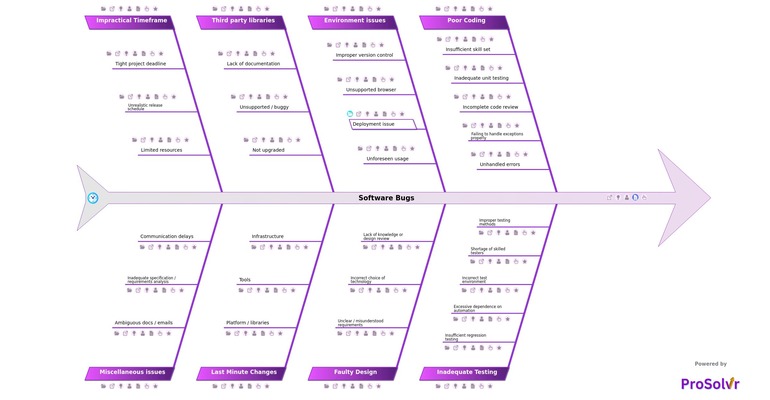Root Cause Analysis of Software Bugs
Software bugs are flaws or errors in a software program that cause it to behave unexpectedly or incorrectly. These issues can manifest as crashes, incorrect outputs, or performance problems, and they often stem from mistakes in code, incorrect logic, or unexpected interactions between components. Bugs can range from minor inconveniences to critical flaws that disrupt operations, making them a significant concern in software development and maintenance.
Root cause analysis (RCA) using a fishbone diagram is a systematic approach used to identify the underlying reasons for software bugs. Instead of merely addressing the symptoms of a problem—such as fixing a specific error message—RCA seeks to uncover the fundamental issue that led to the bug's occurrence. This process involves gathering data, analyzing the problem's context, and examining the conditions under which the bug arose. By identifying the root cause, developers can implement more effective fixes and prevent the issue from recurring.
Implementing RCA can significantly enhance software quality and development efficiency. By addressing the core problem rather than just its manifestations, teams can ensure that similar bugs are less likely to reappear. Furthermore, Gen-AI powered RCA helps in improving overall development practices, as it encourages a deeper understanding of the software's behavior and design. This proactive approach ultimately leads to more robust and reliable software, reducing long-term maintenance costs and improving user satisfaction.
Who can learn from the Software Bugs template?
- Software Developers: Developers benefit from root cause analysis as it helps them understand the underlying issues in their code. By learning from past mistakes, they can refine their coding practices, avoid common pitfalls, and enhance their problem-solving skills.
- Quality Assurance (QA) Engineers: QA engineers can use root cause analysis to better identify and reproduce bugs during testing. Understanding the root causes helps them design more effective test cases and improve their testing strategies, leading to higher-quality software and fewer post-release issues.
- Project Managers: Project managers can gain insights from root cause analysis to improve project planning and risk management. By understanding recurring issues and their origins, they can better allocate resources, adjust timelines, and implement practices that reduce the likelihood of similar problems arising in future projects.
- Product Owners: Product owners benefit from root cause analysis by gaining a clearer understanding of how software issues affect users and the overall product experience. This insight allows them to prioritize features and fixes more effectively, ensuring that critical issues are addressed promptly and improving the product’s value to users.
- Customer Support Teams: Customer support representatives can use root cause analysis to better understand the nature of recurring issues reported by users. This knowledge enables them to provide more accurate troubleshooting guidance, communicate effectively with both users and developers, and reduce the frequency and impact of support tickets.
- Training and Documentation Specialists: Specialists in training and documentation can leverage insights from root cause analysis to create more effective educational materials. By addressing common issues and their solutions in training resources and documentation, they can help new team members avoid the same mistakes and improve their understanding of software development and maintenance practices.
Why use this template?
Using a fishbone diagram for root cause analysis in addressing software bugs offers several key benefits. This visual tool helps systematically identify and categorize potential causes of a problem by breaking it down into various contributing factors, such as people, processes, and technology. By organizing these factors in a structured manner, the fishbone template facilitates a comprehensive examination of all possible root causes, making it easier to pinpoint the underlying issues. This approach not only enhances the accuracy of identifying the true sources of bugs but also promotes collaborative problem-solving among team members, leading to more effective and targeted solutions, improved software quality, and a reduction in the recurrence of similar issues.
Draft and create a template for problem analysis in ProSolvr by smartQED.
Curated from community experience and public sources:








